More of your potential customers are turning to AI search tools like ChatGPT to find what they need. To stay visible, your brand needs to show up there—on top of your usual SEO efforts.
In fact, Semrush data suggests that traffic from large language models (LLMs) will overtake traditional organic search traffic by early 2028.

This guide explains the fundamentals of ranking in AI search results and the tools you can use to optimize your content for platforms like ChatGPT and Google’s AI Mode.
1. Track and Benchmark Your AI Presence
Start by analyzing your current AI search presence to see what’s working, what needs improvement, and how you stack up against the competition.
There are three layers to this:
Layer 1: Visibility and Brand Narrative
This involves understanding which AI platforms mention your brand, exactly how they present it, and how you compare to your rivals.
I spoke with Alex Birkett, co-founder of organic growth agency Omniscient Digital, about how his team uses AI visibility to fuel growth—for themselves and their clients.
Alex told me:
“I want to see if my brand and product are described accurately, consistently. Is the sentiment positive or negative? Visibility is not the only goal.”
To check this for your business, head to the Semrush AI SEO Toolkit, add your domain, and explore the “Brand Performance” report.
First, analyze your share of voice by platform—this is a measure of your visibility in AI answers vs. your competitors on platforms like Google AI Mode, ChatGPT, and Perplexity.
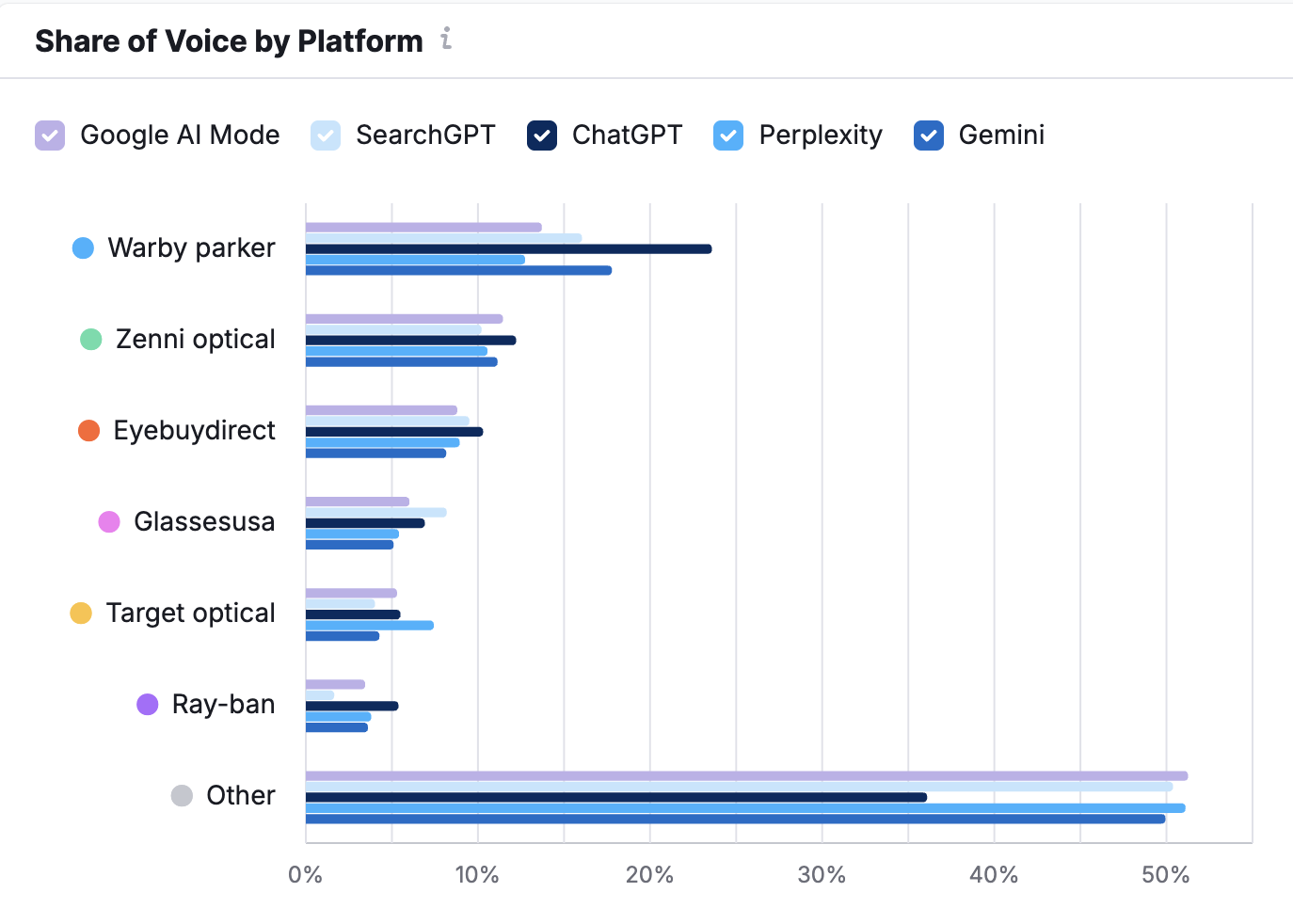
Then, review your share of voice alongside your brand sentiment score.
This shows how often you appear in AI answers, and whether that visibility is framed positively or neutrally compared to your rivals.

Finally, dig into the “Key Sentiment Drivers” section to understand the specific strengths and weaknesses that shape your brand’s narrative in AI answers.
This helps you ensure the AI tools are representing your brand correctly. And spot the gaps you need to address.

Layer 2: Direct Traffic Contributions
The next step is to see if AI citations actually drive visitors to your site.
But here’s the thing:
AI mentions don’t always translate into instant traffic, since users might:
- Not click links at all
- Visit later from another device
- Search for your brand instead of following the citation
But there are ways to track this impact. Alex recommends the following approach:
“Dig into referral traffic, direct log files, and any other data that approximates a click or a crawl from an AI platform to your site.”
First, check your analytics for AI-specific referral sources.
In Google Analytics, open “Reports” > “Acquisition” > “Traffic acquisition” and switch the primary dimension to “Session source/medium.”
Look for AI-specific referrers like:
- chatgpt.com / referral
- perplexity.ai / referral
- copilot.microsoft.com / referral
You can filter the results to identify these faster.

These results give you an indication of the number of people clicking through to your site from AI tools.
Next, check your server log files. These are records of every request made to your site.
Download them from your hosting or via FTP/SFTP, then upload them to Semrush’s Log File Analyzer for easier analysis.

Open the latest log file and search for user agents like ChatGPT-User or PerplexityBot. This will show when AI tools visited your pages, even if those visits don’t appear in analytics.
This data isn’t going to be conclusive. But it can at least indicate whether these tools are able to access and crawl your site.
Further reading: What Is a Log File Analysis? & How to Do It for SEO
The Site Audit tool can also flag AI crawlability issues to help you spot and fix problems that may prevent AI tools from accessing or citing your pages.
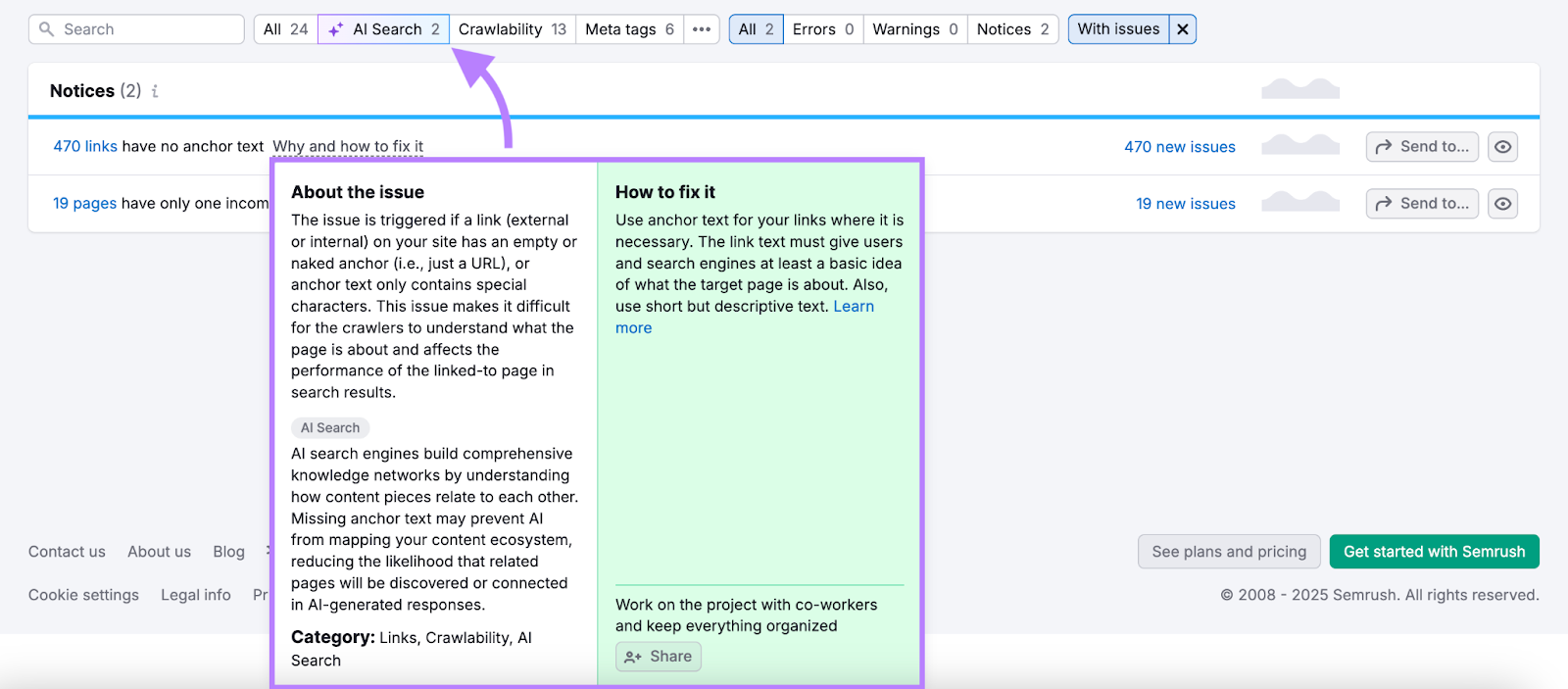
Layer 3: Business Impact
The third layer involves tying this activity to business outcomes like demo sign-ups or purchases.
People may see your brand in an AI answer but take action later, on another device, or through a different channel. So it’s not always possible to link AI search appearances directly to conversions.
However, you can:
- Track conversions from AI referral traffic and from direct traffic spikes that may have been influenced by AI mentions
- Get direct attribution insights from sales calls by asking your customers questions like “How did you first hear about us?” or “What prompted you to get in touch?”
- Add a “How did you hear about us?” field to demo forms or post-purchase surveys and include “AI search (e.g., ChatGPT, Perplexity)” as an option
“We get a substantial portion of our leads from ChatGPT mentions. Just yesterday, I had a sales call where the prospect screen-shared and showed me the exact prompts she used to find us.”
2. Build Brand Authority and Be Present Where it Matters
When your brand is recognized and talked about across the web, it’s far more likely to show up in AI-generated answers.
Research from Kevin Indig shows that brand search volume is the strongest predictor of brand mentions in AI chatbots—especially in ChatGPT.
But it’s not just about being well-known. You also need to be present in the right places—and cited for the right reasons.
Here are some effective tactics that can help you do this and increase your brand’s footprint:
- Guest post on reputable publications so your name and expertise appear in trusted sources LLMs may reference
- Collaborate with industry experts on webinars, reports, or joint research that earns natural AI mentions
- Publish data-driven studies that others in your niche can quote and link to in their own work
- Be active on platforms like Reddit, LinkedIn, or specialized forums where your insights can spread organically
- Repurpose your strongest content into multiple formats (like articles, podcasts, and videos) so it’s discoverable in more sources that AI tools can reference
For example, HubSpot built a large, expert-led content library on sales, marketing, and AI. The content combines original opinions, data insights, and free tools.
This content provides unique value and gets frequently shared, referenced, and mentioned by the community.
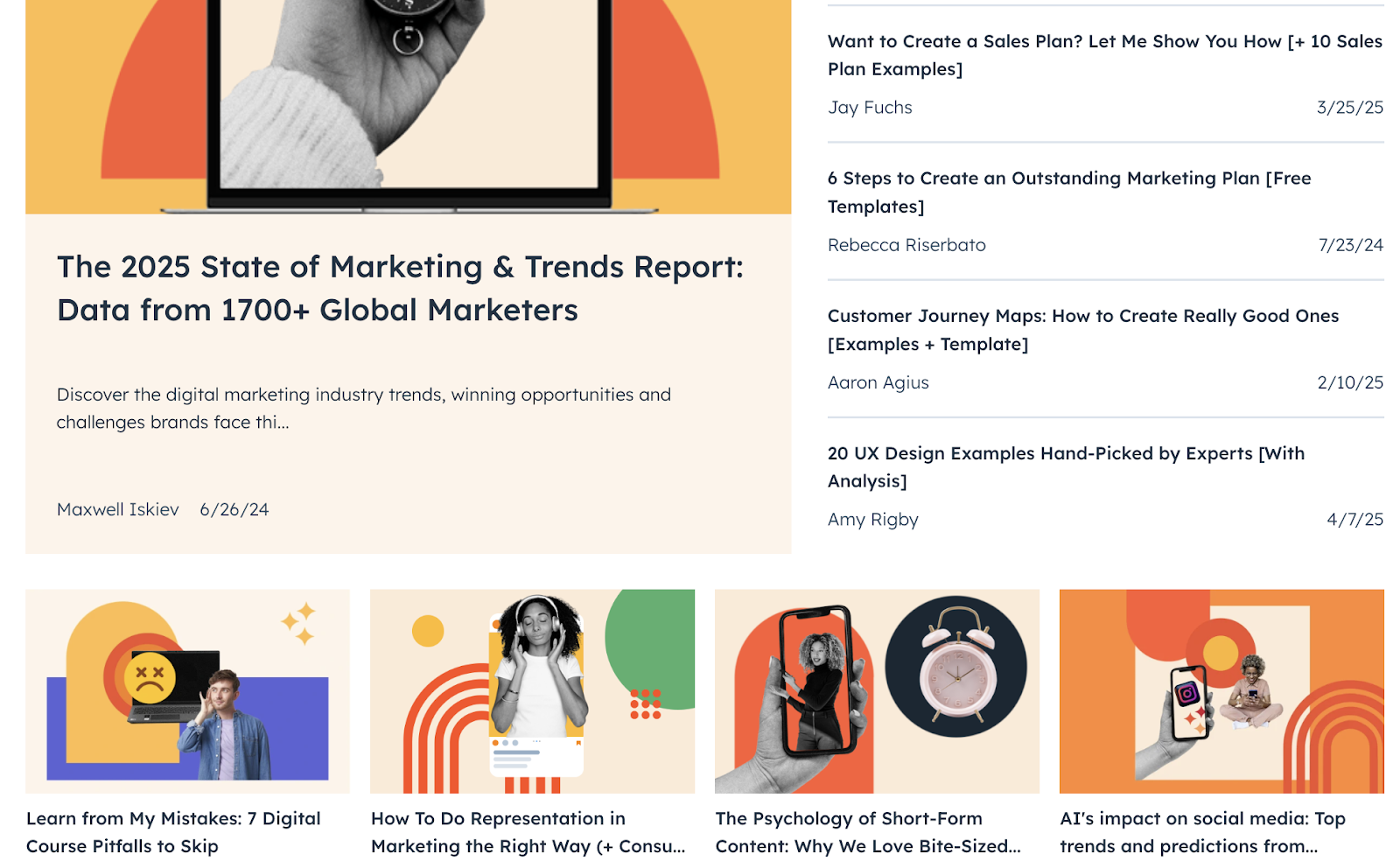
HubSpot also has its own active subreddit with 14K members:
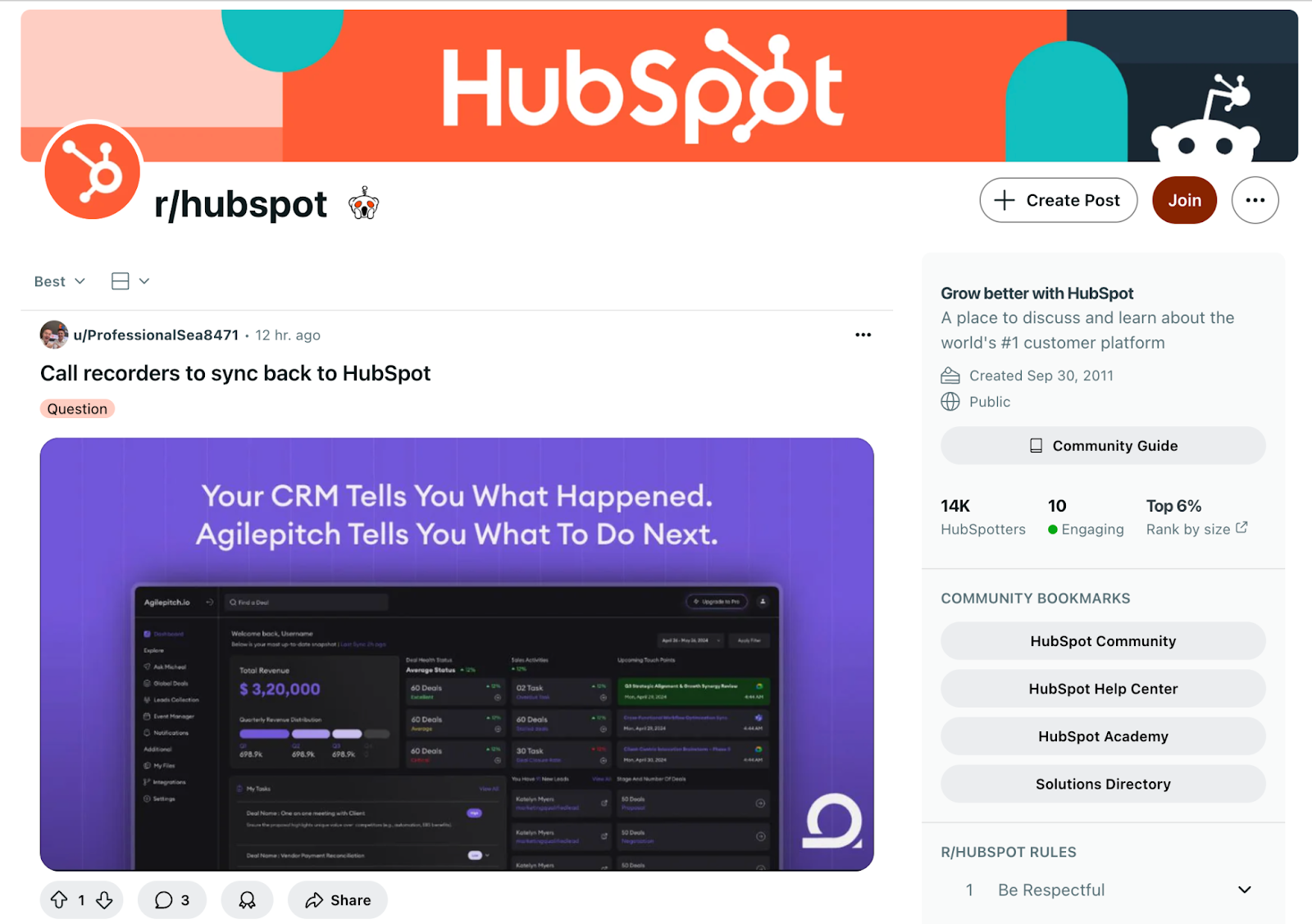
The result?
The brand consistently ranks at the top of high-intent AI searches for topics like CRM and marketing automation.
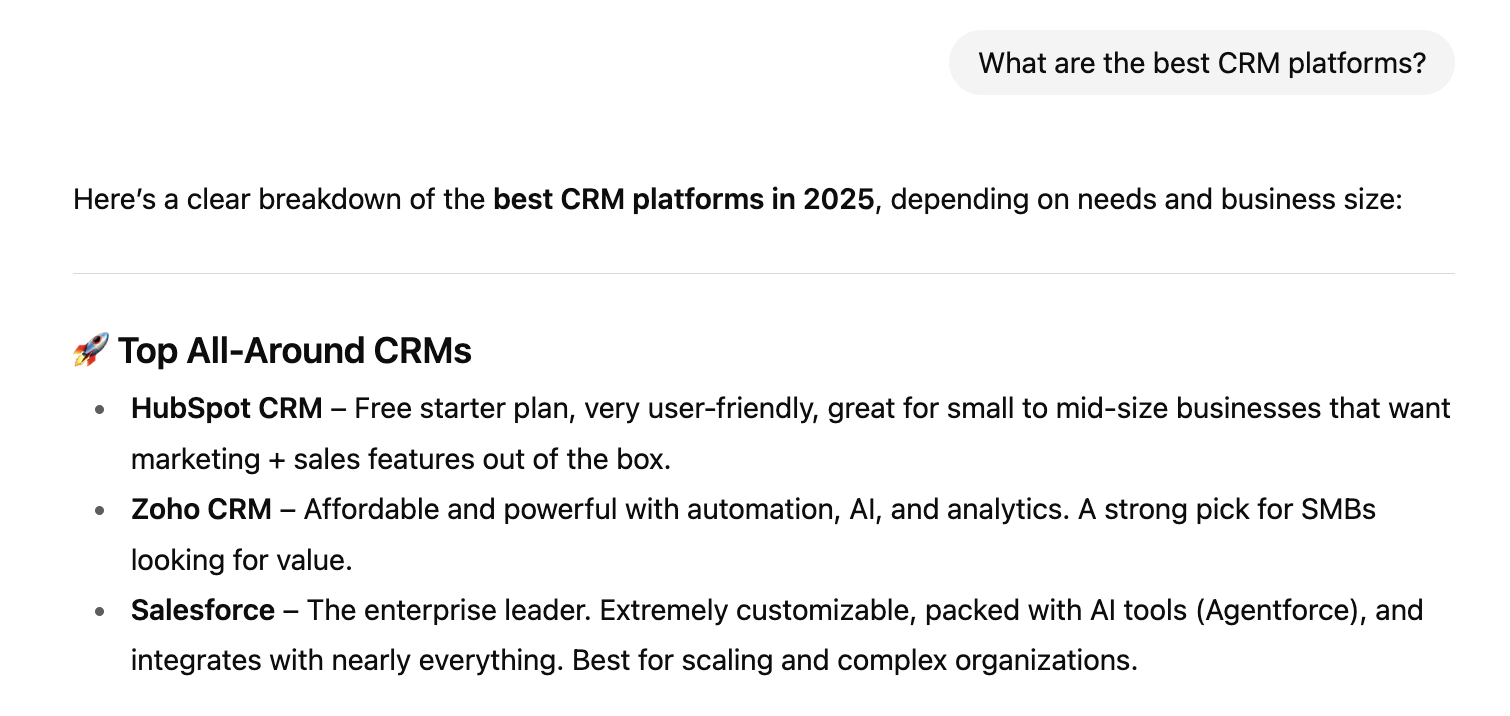
3. Structure Your Content for AI Extraction
Structuring your content so that it’s easy to read and understand also boosts your chances of being included in AI-generated answers.
Why?
Because AI systems don’t just read words, they interpret context.
The way you structure your content tells them what’s important and how the ideas are connected. They then use this context to help form their responses to user prompts.
To put this into practice:
- Use a clear heading hierarchy (H2s, H3s, etc.) to define topic boundaries and make scanning easier for AI tools (and users)
- Write short, simple sentences with clear links between the different concepts you’re discussing
- Add semantic HTML and schema markup (like FAQPage, HowTo, and Review) to provide machine-readable context
- Front-load your answers so the key information appears early
- Use concise formats like bullet points, tables, and Q&A blocks to make it easy for AI tools to extract answers from your content
For example, this Semrush article on Google's AI Mode opens with a clear heading phrased as a question.
It then follows immediately with a short, direct answer.

The article also uses side-by-side comparison tables that present important information in a clean, structured way that AI systems can easily lift and use in their answers.
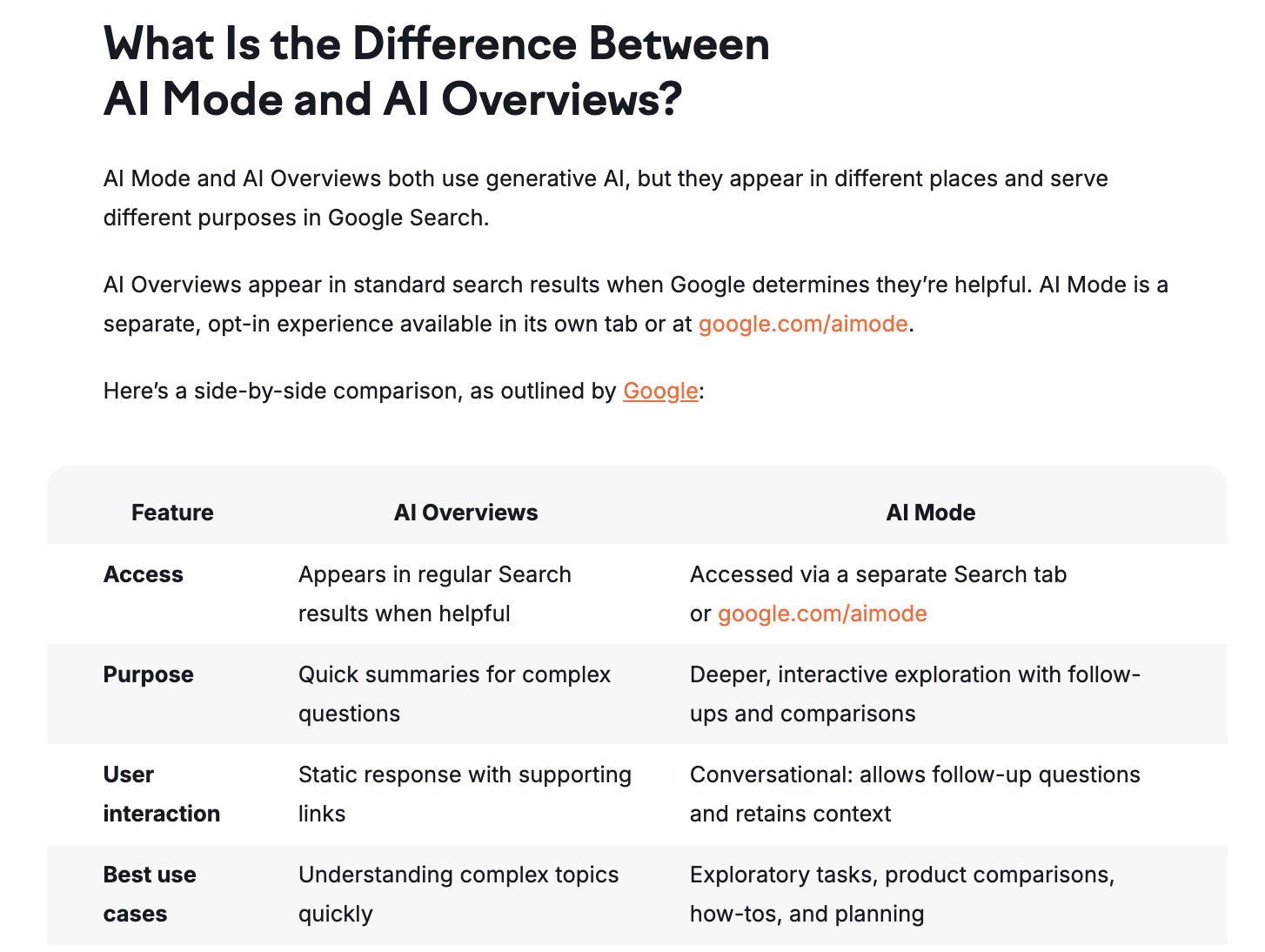
Finally, it features question-based headings followed by concise responses before moving into more detail.
This mirrors the Q&A style that AI models can easily pick up on.

All of this helps make the content more likely to get cited in AI tools like ChatGPT:
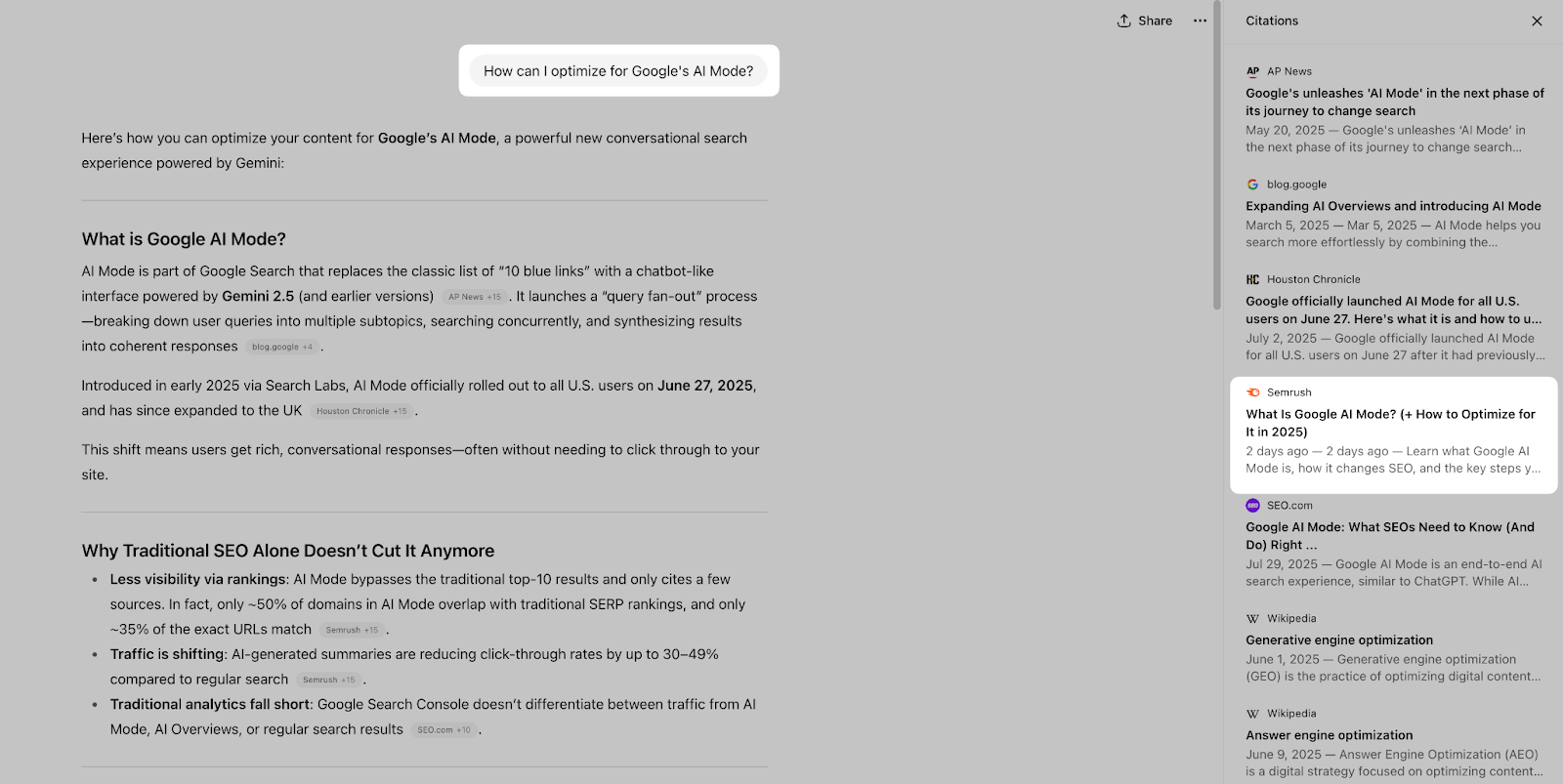
4. Refresh Your Content Regularly
LLMs show a clear preference for content that’s recently published or refreshed. So, it’s a good idea to regularly audit and update your content.
Seer Interactive’s study of 5,000+ URLs found that nearly 65% of AI bot hits targeted content that had been published in the past year. And almost 90% were on pages that had been updated in the past three years.
Only 6% of hits landed on content that was 6+ years old.
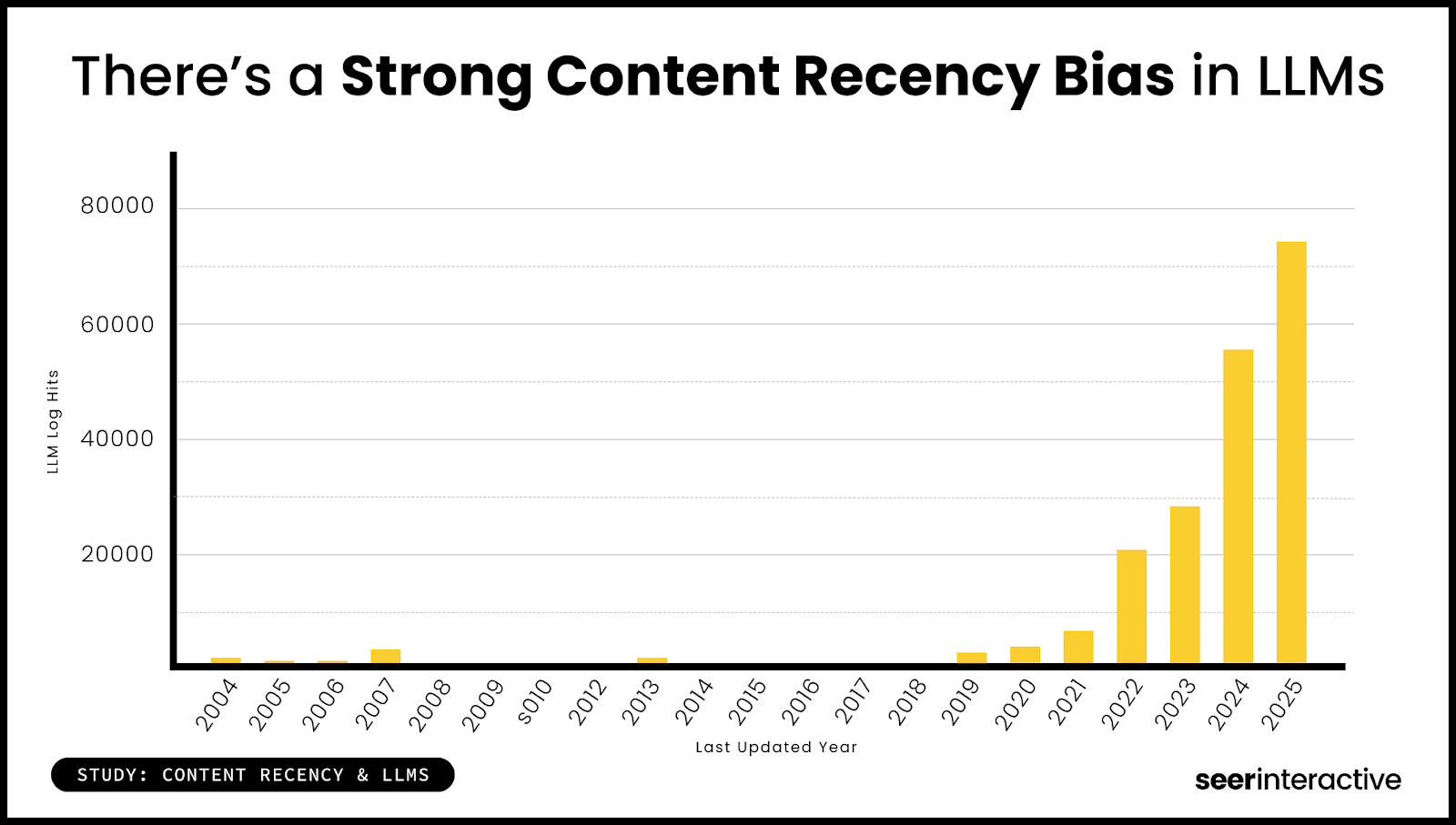
To effectively keep your content up to date, focus on meaningful updates that prioritize relevance and accuracy:
- Replace outdated numbers with the latest studies, reports, and benchmarks
- Add new examples or case studies that highlight recent industry shifts, product launches, or success stories
- Cover new tools, strategies, or practices your audience is searching for
- Fix broken or outdated links and ensure every external reference is still valid and trustworthy
- Reoptimize for keywords and content structure to align with current search demand and AI prompts
- Update charts, screenshots, and graphics so they reflect current interfaces and data
For example, I recently updated my article on SaaS content marketing strategies. I improved the flow, added fresh examples and statistics, and reflected new trends like the use of AI.
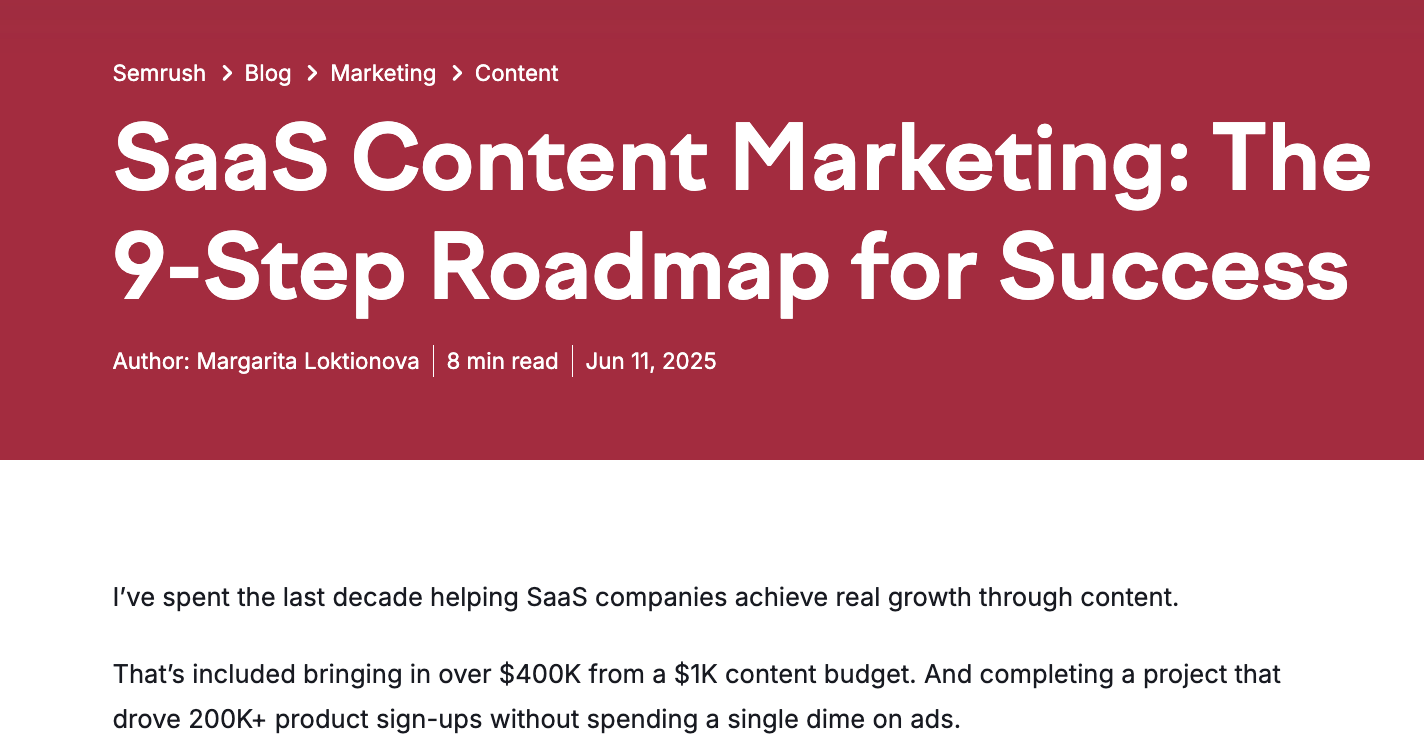
As a result, AI tools like Perplexity now pick it up for relevant queries:
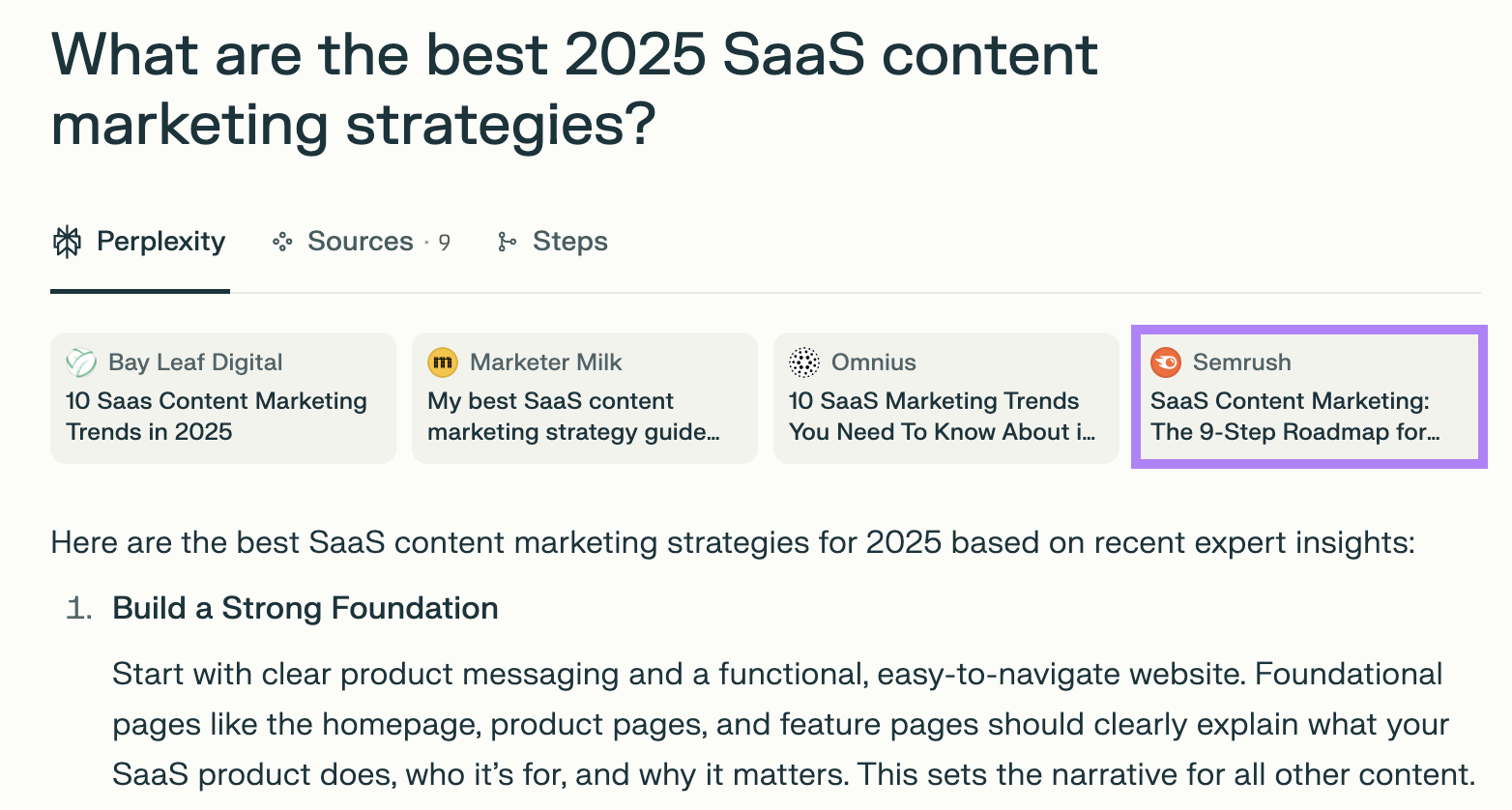
This helps Semrush stay top of mind for SaaS businesses looking to grow their content programs.
5. Build Content Based on Real Customer Questions
Another powerful way to boost your visibility in AI search is by creating pages that directly answer the real questions your customers are asking.
Why?
Because AI tools let users ask highly specific, detailed questions—much more detailed than your typical SEO keyword.
To uncover these queries, start by analyzing your first-party data.
This includes sales calls and demo transcripts, customer support tickets, chat logs, and even Google Search Console data on branded keywords.
These often reveal:
- Repeated questions
- Objections
- Comparisons to competitors
- “How do I…” or “why isn’t this working…” kinds of questions
Moving away from your own data, forums and social media platforms can help you understand how your target customers actually talk about their challenges.
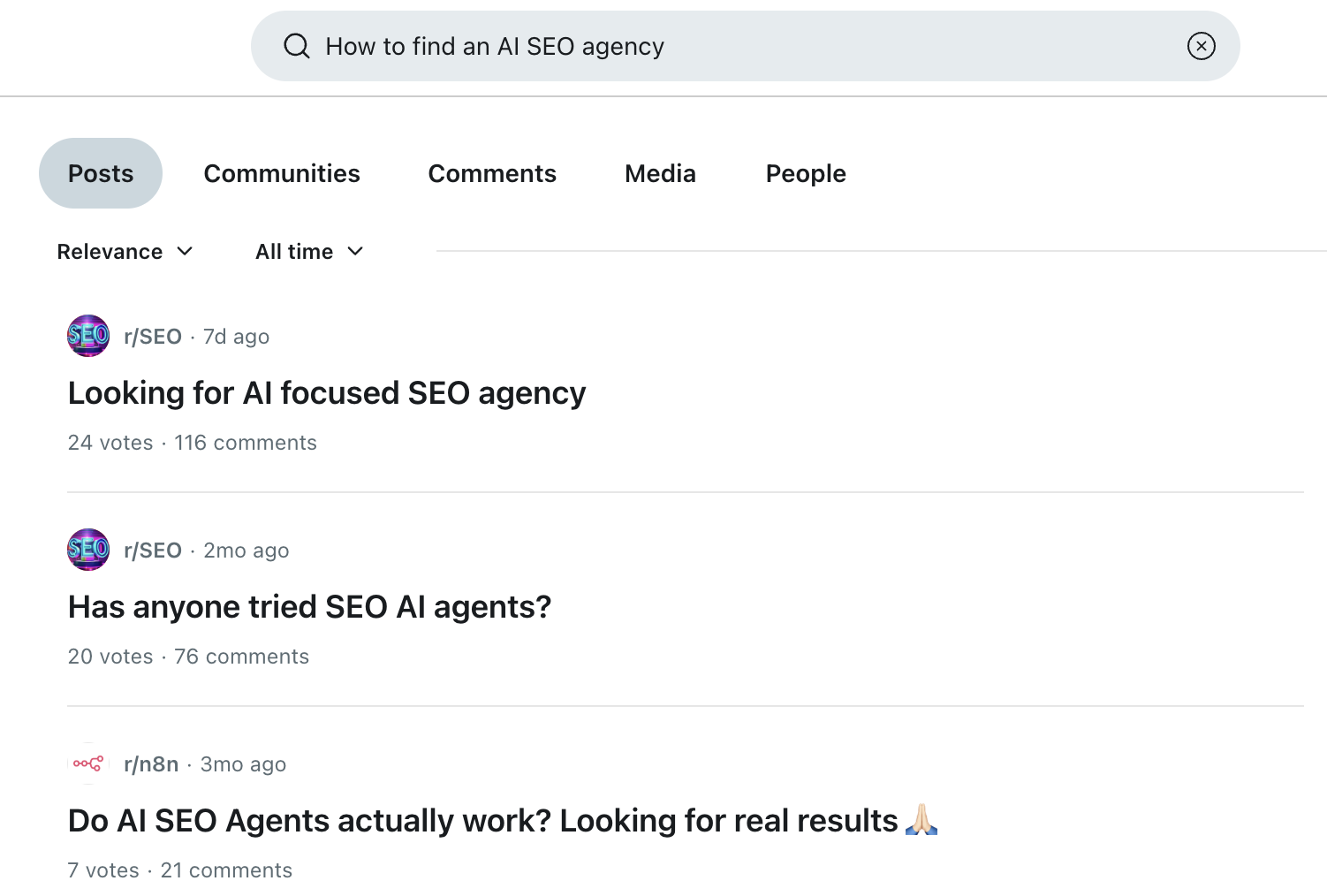
Finally, specialized generative engine optimization (GEO) tools like Semrush’s AI SEO Toolkit highlight the questions AI engines are citing most frequently.
For example, Chargeblast, a fintech company specializing in chargeback solutions, used the AI SEO Toolkit to identify multiple prompts related to its industry.
They focused on prompts where the brand either wasn’t ranking strongly or was completely absent compared to other niche players.

Then, the Chargeblast team mapped out a full content plan from this data and began creating content to close the gaps.
“With the prompts from the AI SEO Toolkit, we've created targeted blog content to match these opportunities. We're trying to be at the forefront of chargeback-related queries by aligning our content strategy with what people are actually asking on AI platforms.”
The company found relevant queries like “Are there chargeback solutions specifically for subscription-based businesses?” and added new pages targeting each of them:

6. Leverage Video as a Citation Magnet
Publishing high-quality YouTube videos can also help you get cited in AI-generated answers.
Semrush data shows that YouTube is the third most-cited domain in AI responses. Videos often appear in tools like ChatGPT and in Google AI Overviews for informational queries in particular.

To win with video, focus on the real customer questions you’ve already identified, using formats like:
- How-to tutorials: Sharing step-by-step guides that walk through a process and provide educational value (e.g.,“How to Build an Email Nurture Sequence in HubSpot”)
- Visual demos: Showing a product, workflow, or technique in action that illustrates exactly how it works (e.g., “Setting Up a Shopify Store in Under 30 Minutes”)
- Comparisons and reviews: Providing side-by-side breakdowns that answer decision-focused queries (e.g., “Mailchimp vs. ActiveCampaign: Which Fits a Small Business?”)
Further reading: Video Marketing: The Ultimate Guide for 2025
Implement These Tactics to Rank in AI Search Responses
AI search is quickly becoming a go-to way for people to find answers and products. That means ranking in AI tool responses to your target audience’s questions is a key way to:
- Stay competitive
- Remain at the front of your target audience’s minds
- Drive more revenue for your business
Semrush’s AI SEO Toolkit makes it easy to monitor and optimize for AI search rankings. Try it today to start improving your AI brand visibility.